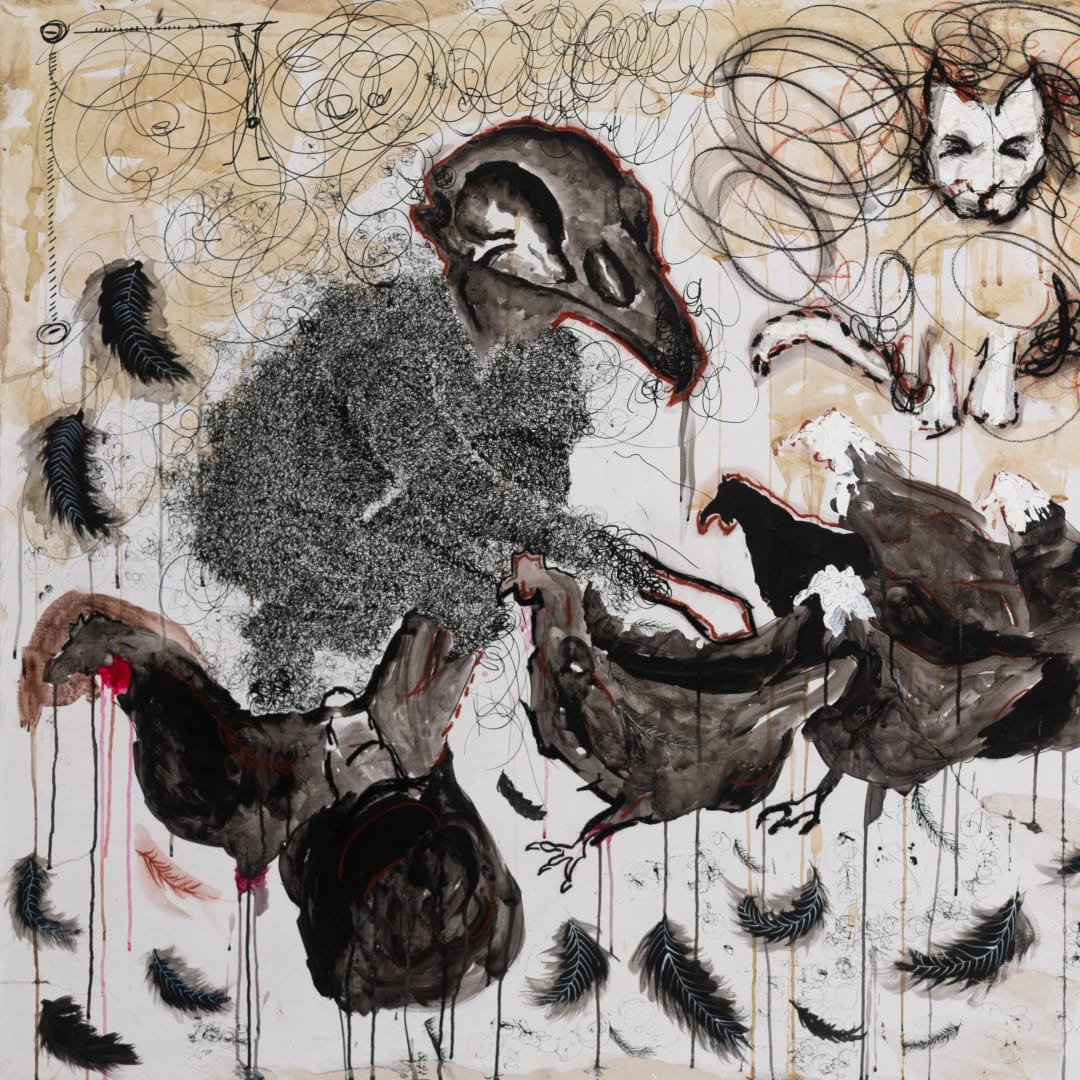Galerie Cécile Fakhoury is pleased to present Paraboles d’un règne sauvage, the first solo exhibition of the Senegalese artist Serigne Ibrahima Dieye.
The darkness of a long corridor, a compulsory path to enter the exhibition, enshrouds us. Shapes, words - red - can be read, resonate. In this corridor, a feeling of confinement takes hold of the body. The uneasiness, too, of not knowing the outcome with certainty. The installation L’arme à gauche (2020) is an airlock, a buffer zone whose function is in every way similar to any other airlock and buffer zone in our contemporary world, that of a bank, an airport, a hospital. Their purpose is to make us understand - and also feel, deep down inside - that we are entering a particular territory whose rules do not belong to us and to which we must submit ourselves. Then to judge everyone’s eligibility to enter this territory according to several criteria: are you of the right nationality, do you have enough money, are you not ill.
On the wall, Serigne Ibrahima Dieye wrote the names of those who never made it to the end. Amos, Aïcha, Delphine, names that evoke different temporalities, geographies and cultures; none is spared. These names remind us of the implacable arbitrariness of the global system. So, going through the installation from beginning to end is an agreement in principle that amounts to accepting the terms of the exhibition as defined by the artist. At the end of the corridor, the installation continues as a warning: hanging heads have shed their religious attributes that have fallen loose on the ground. Simulacra of hanging, we are all the same in the death that will catch us indiscriminately, perhaps faster if you choose dissidence in this world.
Here, one should not hope to enter a bubble pacified by art and beauty, nor find a solution. In each work, Serigne Ibrahima Dieye summons the chaos of the world as a matter of creation and chooses to tell us its darkest fables. Paraboles d’un règne sauvage is a dystopian plastic tale.
In each work, places and characters are sketched without ever being named. Nevertheless, they remain familiar to those who look at them attentively. Serigne Ibrahima Dieye draws his subjects as much as his forms from current events. The composition of the scenes in his paintings and drawings could be that of press photographs taken in war zones, disputed borders, refugee camps; images of contemporary geopolitical misfortunes to which one has painfully become accustomed.
Yet the human figure is almost entirely absent from Dieye’s works. When it is represented, it is in the form of skulls, returning from beyond the grave marked by failure. Instead, a dark carnival of anthropomorphic figures, human bodies with animal heads, bird skulls, sheep and small rodents, macabre attributes displayed without embarrassment and busy with the only task they can do: that of annihilating the body of the other as was their own. Of course, no one is fooled: the use of Dieye’s animal figure is a radical mise en abîme. It is no longer simply a matter of the artist using the wild characters of animals as a pretext to portray the brutality of man. On the contrary, by choosing animal figures that have nothing to do with the situation depicted, Dieye highlights the inextricable human vanity that seeks by all means to justify itself.
Then, like a subliminal image that would spring from the successive contemplation of the works of Serigne Ibrahima Dieye, the silhouette of a multi-headed monster created by the excessiveness of men appears between the lines. This monster is called Neo-capitalism. Corruption. War. Exploitation of resources. Exploitation of men. Xenophobia. From one work to the other, the avatars of this monster manifest themselves - creativity inversely proportional to the darkness of the evils - through the richness of the techniques used by the artist: the silkscreen prints of Gazelle beers; photocopies of banknotes; circular clouds of Indian ink that give body to the characters but always threaten to evaporate; the evanescence of acrylic paint diluted in water giving sometimes a yellow and sometimes a blue-grey cloud like polluted smoke. In Dieye, the plastic material in all its thickness becomes a tool for denouncing a society where the law of the strongest reigns.
Caught between two antagonistic forces, a binary oscillation between the black and white of the works, the territory of the exhibition extends like a no man’s land, a grey area in which each of us is an agent and responsible for meaning. Serigne Ibrahima Dieye thus pushes us to reflect on the role we have in the construction of the world, on our share of individual responsibility, while at the same time making the creative gesture a privileged act of resilience in the face of the abyss.

